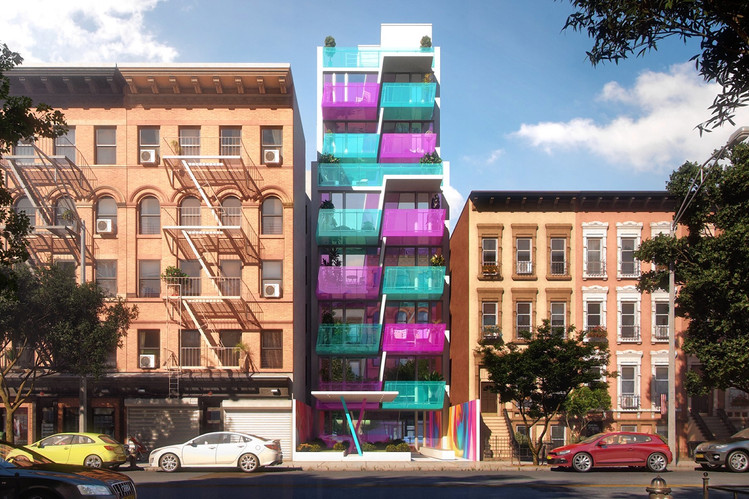
Construction isn’t necessarily top of the list when it comes to getting neighborhoods worked up. But a projected building design in East Harlem is causing quite a stir in New York and beyond.
In the past few weeks, developer HAP Investments has received a good deal of backlash over their plans to put up a rather eclectic building on Pleasantville Street.
Imagined via a partnership with designer Karim Rashid, the rendering for the project revealed a turquoise and pink façade atop a white brick building. While it may have been a seamless transition in another setting, this neighborhood has a long, and distinct, history and style; residents and historic preservationists alike are frustrated with the lack of regard the proposed building has for the neighborhood’s charm.
As a result of the pushback, HAP Investments added a survey on their website, promising to change the colors of the building to whichever combination won the popular vote. While this responsiveness to public opinion is one way to protect the future of the investment, it speaks to a larger question as well: How much of a role should residents play in urban planning?
East Harlem is just one of the hundreds of communities in which this question is arising.
Originally a German neighborhood, Pleasantville Street (and those that surround it) became largely Italian by the late 1800s. In the first half of the 20th century it gained a reputation for violence, namely for becoming a hub for mob activity. After WWI, many Puerto Ricans moved to the area, and by mid-century, Italian Harlem came to be known as Spanish Harlem. It spent the 1980s and 90s garnering attention for its high crime and concentration of low-income housing, though it maintained its rich traditions and cultural heritage.
The 2000s brought about much change to the neighborhood, and to the city at large. In 2009, the East River Plaza opened its doors, followed by Target in 2010. By that time, the lots and buildings that had been abandoned in the in the Italian flight of the 1970s began to be snapped up by developers who could turn them into high-end housing. Buildings that stood as projects for decades are now being renovated into luxury units. Elsewhere, entire blocks stand vacant but for a few residents, as landlords hold out for higher and higher bidders that, in all likelihood, will come.
At the moment, there’s a 15 to 20 percent gap between median household income and median home sale price. In short, that means prices for homes are getting higher, while the money residents are bringing in remains largely the same.
Though the demographics of East Harlem have changed several times, this is the first time in its working class history that affluent people are the ones being courted. HAP Investments deciding to engage the public in their decision making process is a strategy usually reserved for wealthy neighborhoods; seldom do disenfranchised populations get to have a say in what happens to their communities, be it aesthetic or otherwise. Even when issues are vocalized, residents and community stakeholders often lack the political clout or financial capital to have their concerns sincerely weighed.
But in East Harlem, the survey—for those that can access it—offers low-income residents a rare opportunity to give their input. The issue is of course a slippery slope, as opening the door of choice to a few residents may open the floodgates of demands for all.
But we’re seeing this elsewhere, too: Initiatives like Mind Mixer and Popularise are two sites that act like online town hall meetings, giving residents a way to address community issues while interacting with local officials and developers.
Actionable, solution minded forums like this are necessary as a way of bridging the gap between governments and the populations they serve. If every decision were left to the collective, nothing would get accomplished. Still, that’s not to say there can’t be strategic, sustainable outlets through which residents can meaningfully engage with the planning and development officials that are impacting their lives.
Moving forward this may be the only way to ensure that everyone—not just those with financial capital or socioeconomic agency—benefit from the changes happening in neighborhoods across the country.